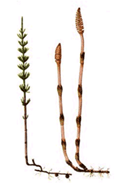
Horsetail
Introduction
This fact sheet provides basic information about Horsetail. This plant is native to Europe, North America, North Africa, and northern Asia. Horsetail is a pteridophyte more closely related to ferns than to flowering plants and produces spore-sacs that are visible during March through September. This small, deep-rooted, rush-like perennial grows to about 0.3 m. It has hollow, pointed stems, scale-like leaves, and no flowers. Horsetail grows best in moist and shady areas.Traditionally, the plant has been used as a diuretic, an antitubercular drug, and in the treatment of genitourinary and respiratory disorders, arthritis, and bleeding ulcers. Owing to the abrasive nature of its high silica content, horsetail has been used to clean dishes, sand wood, and polish metal. Externally, it has been used in cosmetics and as an astringent to stop bleeding and stimulate wound healing.
Common Names
Horsetail, Bottle Brush, Scouring Rush, Shave Grass, Dutch Rush, PewterwortLatin Names
Equisetum arvenseWhat It Is Used For
- Horsetail has been used as a diuretic, in the treatment of kidney and bladder ailments, as an astringent to stop bleeding and stimulate healing, as an antitubercular drug, and as a cosmetic component, although there is a lack of clinical trials.
- NutritionalTree.com is a great consumer resource that collects user reviews for horsetail products.
How It Is Used
A tea is prepared by pouring boiled water over 2 to 3 grams of horsetail herb, boiling for five minutes, and then straining after 10 to 15 minutes. Drink during the day between meals. An infusion for internal use is made by adding 1.5 grams of horsetail herb to 1 cup of boiling water. Let it steep for 30 to 40 minutes.Dosages:
- Internal: 6 g daily (recommendation by the German Commission E monograph)
- Herbal infusion: 4 oz three times daily
- Tincture (1:5): 1 to 4 mL three times daily
- External (compresses): 10 g of herb per 1 liter of water daily
What the Science Says
- Research reveals no animal or clinical data regarding the use of horsetail for diuretic effects.
- The historical data reporting the use of horsetail in the treatment of urological disorders, tuberculosis, or to enhance wound healing have been neither confirmed nor disproved.
Side Effects and Cautions
- Horsetail has been listed as an herb of undefined safety by the FDA. Ingestion of large amounts of the fern may be toxic. There have been reports of children being poisoned by using the stems as blowguns or whistles.
- Crude horsetail contains the enzyme thiaminase, which destroys the B-vitamin thiamine.
Sources
- Drugs.Com Web site. Accessed on February 6, 2009.
- From Wikipedia, the free encyclopedia. Accessed on February 6, 2009.






